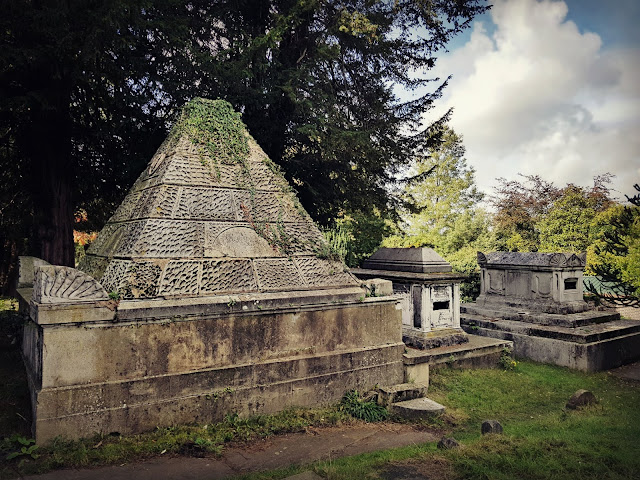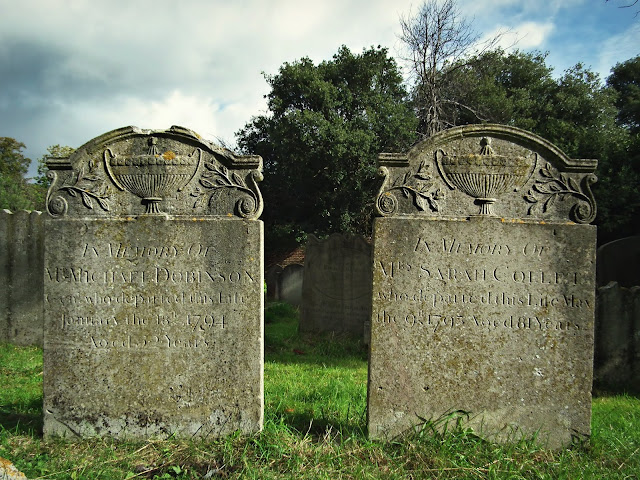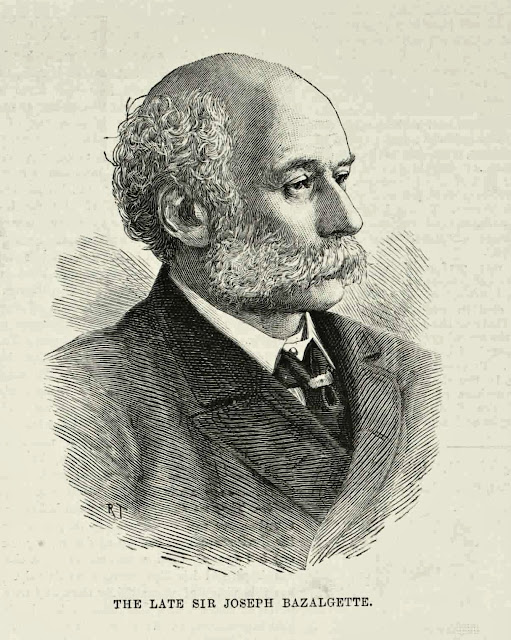 |
| The tomb of William Mansel Phillips of Coedgair in Carmarthenshire, second son of Sir Wm Mansel baronet of Iscoed in the same county, and of Caroline his wife, only child of Benjamin Bond Hopkins Esq |
St
Mary’s in Wimbledon was my first stop on a day of cemetery touring – from here
I planned to walk on to Gap Road Cemetery and then to Lambeth Cemetery in
Tooting. St Mary’s was only on the list because I had wanted to see the tomb of
Sir Joseph Bazalgette for some time; I didn’t expect to spend long in the
churchyard, a quick look around to see if there was anything else of interest
and then 15 minutes to take a few photos of the Bazalgette mausoleum. The entrance to the churchyard is at the end
of a short road with an open field to one side and an eye catching Victorian
stuccoed hunting lodge to the other with its larger than life reclining stag
staring impassively from the roof top cornice. St Mary’s, with its 196 foot spire, is a Sir George
Gilbert Scott gothic revival rebuild from 1843 of an older, Georgian church though
there has probably been a church on the site since before the Norman Conquest. As I had done no research I was taken by
complete surprise at the variety and quality of the memorials in the
churchyard. According to the church’s website “along with Chiswick and
Hampstead, Wimbledon churchyard possesses the highest concentration of listed
monuments anywhere in Greater London.” There are 25 Grade II listings in total
for headstones and memorials in the churchyard which, given that the old part
of St Mary’s where all the listed memorials are, is far smaller than St
Nicholas’ in Chiswick or St John-at-Hampstead probably means more listings per
square foot than either of its rivals.
 |
| The tombs of Louisa and Margaret Bingham (Countesss Lucan) and of Georgiana Charlotte Spencer Quin |
In
the 1810 edition of The Environ’s of London Daniel Lyson says “in the
church-yard are tombs of Gilbert Smyth, M.A. of Christ's College, Cambridge,
who died in 1674; John Simpson, "a zealous "minister of Christ, who
was blessed with the conversion of very many souls in the city of London;"
he died in 1662; Thomas Pitt of London, merchant (1699).” I couldn’t find
anything quite that old but there are many finely preserved 18th century
headstones. The first monument that really caught my eye was because of the
surname; Historic England list it as the Bingham tomb and describe it as a “pedestal
tomb. Circa early C19. Portland stone. Greek Revival manner. Stepped base with
circular pedestal surmounted by triangular block, inscribed, corniced, having
low pedimented projections and corner acroteria. Urn finial on cylindrical
pedestal.” The inscription on the front says ‘Louisa Bingham second daughter of
Charles Earl of Lucan and of Margaret his wife. She died in 1784 in the 20th
year of her age.’ Also buried here is her mother; the inscription on the
reverse reads ‘Margaret Countess of Lucan, Widow of Charles Earl of Lucan and
daughter and coheiress of James Smyth of St Audries in the County of Somerset
Esq. and of Grace Dyke of Pixton in the County of Devon his wife. She died in
1814 in the 73rd year of her age.’ Margaret Bingham (1740-1814) was the wife of
the first Earl of Lucan and was much admired by Horace Walople for her beauty
and her talent as an amateur artist. Just a few yards away is the memorial for Georgiana
Charlotte Spencer Quin, a “tall rectangular pedestal surmounted by rectangular
inscribed block with quilloche frieze and cornice, and corner acroteria,”
according to Historic England. Georgina was Margaret’s granddaughter who died
in childbirth at the age of 29 in 1823. Her baby only survived 9 weeks and was
interred with her mother. Georgina’s mother was Lavinia Bingham, Margaret’s
eldest daughter, who married George Spencer, Viscount of Althorp and 2nd Earl
Spencer. Margaret’s descendants include her great great great great great granddaughter
Princess Diana (daughter of the 8th Earl Spencer) and her great great great great grandson
Richard John Bingham, the 7th Earl of Lucan who was, of course, notorious for allegedly
bludgeoning the family nanny to death
with a piece of bandaged lead pipe in 1974 and never having been seen since.
 |
| Vulture Hopkins |
During
the 1869 Christmas holiday the poet Gerard Manley Hopkins, who was then a Jesuit
novice at Manresa House in Roehampton, walked across Wimbledon Common to St
Mary’s to take a look at the church and
churchyard. He was delighted to come across the tomb of William Mansell Philips
of Coedgair in Carmarthenshire and his wife Caroline, only child of Benjamin
Bond Hopkins. Although born in Stratford in East London Hopkins was proud of
his Welsh lineage – he also had Mansel
cousins – and he felt that the occupants of the fine chest tomb with its imposing
coat of arms must be distant relatives. As he wandered around the churchyard he
also came across the grave of John Hopkins, known as Vulture Hopkins. On 30thh
December he wrote to his mother thanking her for her Christmas present of
flannel shirts (his old ones really were, he said “very absurd things, for they
were so small that the waists were somewhere near my shoulders, and they were
rotten with age…”) and telling her about his discoveries in St Mary’s:
I
have found out something which may interest my father. In Wimbledon church near
here there is a marble tomb on which our arms and crest caught my eye. It is,
so far as I remember the names, the tomb of William Mansel Phillips of Coedgair
in Carmarthenshire, second son of Sir Wm Mansel baronet of Iscoed in the same
county, and of Caroline his wife only child of Benjamin Bond Hopkins Esq. It would
look as if he wore his father-in-law’s arms and crest. I know I have some cousins
the Mansels but I cannot remember anything about them. Besides this there is in
a comer of the same churchyard a tombstone full of Hopkinses beginning with
John Hopkins familiarly known as Vulture Hopkins’ (they should have left his nickname
rest with him. I think he is mentioned in Pope’s satires). The stone is modern,
no doubt replacing some old ones. One would not wish to have anything to do
with the bird but it looks very much as if the Hopkinses had an old connection with
Wimbledon I should like to hear about this anything you know.
John
‘Vulture’ Hopkins was a city financier and speculator, also known as ‘the
Putney Usurer’, who made a fortune speculating in the South Sea Bubble and died
in 1732 leaving a fortune worth £300,000. G.M Hopkins was correct in thinking
that he is mentioned by Alexander Pope. He is also mentioned by Dickens in Our
Mutual Friend, a passing reference which he had got from Frederick Somner
Merryweather’s Lives and Anecdotes of Misers. Merryweather only mentions
Vulture Hopkins when discussing the even more tight-fisted Thomas Guy, in public
a philanthropist (and benefactor of the hospital that still bears his name) but
in private a notorious skinflint;
It
is said that one evening he was sitting in his little back parlour meditating
over a handful of half lighted embers, confined within the narrow precincts of
a brick stove; a farthing candle was on the table at his side, but it was not
lit, and the fire afforded no light to dissipate the gloom; he sat there all
alone planning some new speculation; congratulating himself on saving a
pennyworth of fuel, or else perchance thinking how else he could bestow some thousand
guineas in charity: his thoughts, whether on subjects small or great, were interrupted
by the announcement of a visitor; he was a shabby, meagre, miserable looking
old man; but compliments were exchanged, and the guest was invited to take a seat;
Guy immediately lighted his farthing candle, and desired to know the object of
the gentleman's call: the visitor was no other than the celebrated Hopkins, who
on account of his avarice and rapacity had obtained the name of Vulture
Hopkins. "He lived," says Pope, "worthless, but died worth three
hundred thousand pounds, which he would give to no person living, but left it
so as not to be inherited till after the second generation." His counsel
represented to him how many years it must be before this could take effect, and
that his money would only lie at interest all that time. He expressed great joy
thereat, and said they would then be as long in spending as he had been in
getting it. But the Chancery afterwards set aside the will, and gave it to the
heir at law. The reader will probably remember the lines in Pope's Moral
Essays—
"When
Hopkins dies a thousand lights attend,
The wretch that living saved a candle's
end."
"I
have been told," said Hopkins, as he entered the presence of Thomas Guy, "that
you are better versed in the prudent and necessary art of saving, than any man
now living, and I now wait upon you for a lesson in frugality, an art in which
I used to think I excelled, but I am told by all who know you that you are
greatly my superior." "If that is all you are come about," said
Guy, "why then we can talk the matter over in the dark;" so saying,
he with great deliberation put the extinguisher on his newly lighted farthing candle.
Struck with this instance of economy, Hopkins acknowledged the superior abilities
of his host, and took his leave imbued with a profound respect for such an
adept in the art of saving.
Vulture
Hopkins’ heir at law was one Benjamin Bond a clerk to a city attorney, whose
mother was the daughter of John Hopkins of Bretons in Dagenham and distantly
related to the deceased miser. It took him forty years to inherit; Vulture died
in 1732 but Benjamin didn’t come into his fortune until 1772. To comply with
the terms of the will he took Hopkins as a surname. He bought an estate at
Painshill in Surrey and became a member of Parliament and a financier and speculator
in his own right. He married three times. Daniel Lyson’s says, intriguingly, that
at St Mary’s “At the entrance of the church-yard, on the right hand, is a large
columbarium made by Benjamin Bond Hopkins, Esq. for the interment of his
family. Within it are inscriptions upon tablets of white marble to the memory
of Benjamin Bond, Esq. of Clapham, who died in 1783; his wife Elizabeth, who
died in 1787; and Eliza and Alicia, wives of Benjamin Bond Hopkins, Esq. of
Painshill, who died in 1771 and 1788.” There seems to be no trace of this columbarium
(surely a mausoleum or possibly a vault?). In the tomb of William Mansell
Philips of Coedgair which so intrigued G.M Hopkins is buried Caroline, William’s
wife, and only daughter of Benjamin Bond Hopkins. She would have been a real
catch for William; the Gentleman’s Magazine commented in 1794 “we doubt whether Mr Bond Hopkins's
oldest daughter was not by his first wife. Be that as it may he has left to his
surviving and now only daughter £50,000 when she attains the age of 24 over and
besides 8ool per annum of her mother's jointure.” Benjamin also had an illegitimate son who also
received a considerable inheritance but the majority of the fortune went to
Caroline.
 |
| The tomb of Gerard De Visme Esq of London, Lisbon and Wimbledon |
Apart
from Sir Joseph Bazalgette’s the other remarkable monument at St Mary’s belongs
to Gerrard De Visme who died in 1797. Historic England says the tomb “consisting
of a square plan, rusticated pyramid with corner acroteria to the base. An
acroterion has fallen due to movement in the stone blocks, and another is
dislodged. Slow deterioration continues. A condition survey has been carried
out, funded by Historic England. The church, Local Authority and Historic
England are working together to secure funding to enable the necessary works to
be carried out.” De Visme was a London born merchant of Huguenot descent who
spent most of his life in Lisbon and built a castle at Sintra. He returned to England
to retire at Wimbledon. There will be more about De Visme to come in a separate
post about his tomb and his life.
St
Mary’s has, by and large, managed to keep itself out of the newspapers. One of
the few even remotely interesting stories I could find about it was published
in the Gloucestershire Echo on Monday 07 September 1936;
At
the end of a marriage ceremony at St Mary's Parish Church, Wimbledon, last
Saturday, the organist, Mr. Henry Ralph Wagstaff, aged 65, of Wimbledon,
collapsed and died. The congregation was unaware of his death. Mr. Wagstaff had
been acting as deputy for the regular organist.




















